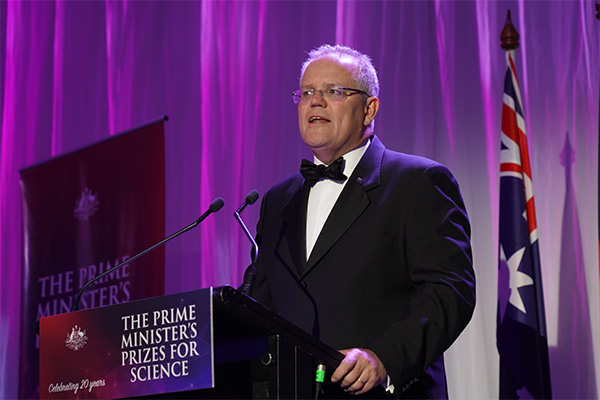
PM Prize awards. Back row left to right: Professor Guillaume Lessene, Professor Andrew Roberts, The Hon Minister Karen Andrews MP, Minister for Industry, Science and Technology, Professor David Huang, Dr Luke Campbell. Front row left to right: Associate Professor Elizabeth New, Dr Samantha Moyle, Mrs Sarah Finney, The Hon Scott Morrison, Prime Minister of Australia, Emeritus Professor Cheryl Praeger, Associate Professor Laura Mackay, Associate Professor Peter Czabotar.
The Australian scientific, research and science teaching community came together to celebrate the achievements of 10 of the country’s leading scientists and science educators.
The 2019 Prime Minister’s Prizes for Science were presented at a black-tie awards dinner at Parliament House in Canberra on Wednesday 16 October.
The Prime Minister’s Prizes for Science are Australia’s most prestigious awards for outstanding achievements in:
- scientific research
- research-based innovation
- excellence in science, mathematics or technology teaching
The Prime Minister and the Minister for Industry, Science and Technology attended the event and awarded the PM Prizes in front of an audience of 500 guests.
Professor Alan Duffy, renowned astronomer and Lead Scientist of the Royal Institution of Australia, hosted the ceremony.
Science and innovation prize recipients
- Prime Minister’s Prize for Science: Emeritus Professor Cheryl Praeger AM FAA FAustMS, a pioneering mathematician who has made fundamental contributions to group theory and combinatorics. Her innovative work includes research into the mathematics of symmetry in graphical models. This has far-reaching applications, such as enabling search engines to retrieve information efficiently from the web.
- Prime Minister’s Prize for Innovation: Associate Professor Peter Czabotar, Professor David Huang, Professor Guillaume Lessene and Professor Andrew Roberts, for their roles in developing venetoclax. This breakthrough anti-cancer drug triggers a signal in cancer cells causing them to die. Their work is based on a landmark discovery at the Walter and Eliza Hall Institute of Medical Research.
- Frank Fenner Prize for Life Scientist of the Year: Professor Laura Mackay, for her leadership in the field of immunological memory. Her work is changing the way science deals with infectious disease and cancer, two leading causes of global mortality.
- Malcolm McIntosh Prize for Physical Scientist of the Year: Associate Professor Elizabeth New, for pioneering new chemical imaging tools to observe healthy and diseased cells. She has developed molecules that act as fluorescent sensors, allowing scientists to observe the location of chemicals within cells.
- Prize for New Innovators: Dr Luke Campbell, for inventing the nuraphone, headphones that automatically learn and adapt to an individual’s unique hearing in under a minute. This enhances audio experience, delivering balanced and clear detail to users.
Science, mathematics or technology teaching prize recipients
Recognised for their contribution to our future generation of scientists:
- Prime Minister’s Prize for Excellence in Science Teaching in Primary Schools: Mrs Sarah Finney (Stirling East Primary School, South Australia) for introducing hundreds of children to the joys of studying science. Mrs Finney has combined life in the classroom with involvement in teaching associations, conferences and speaking engagements, to expand her network and knowledge in the field of science.
- Prime Minister’s Prize for Excellence in Science Teaching in Secondary Schools: Dr Samantha Moyle (Brighton Secondary School) for transforming interactive learning beyond the classroom. Dr Moyle hosts a Facebook page to promote science and learning. Her YouTube channel shows kids how to write science reports, calculate statistics, choose the best iPad app and learn more about science.

The Hon Scott Morrison, Prime Minister of Australia, speaking at the award ceremony.

Emeritus Professor Cheryl Praeger, receiving the Prime Minister’s Prize for Science. With The Hon Scott Morrison, Prime Minister of Australia, and The Hon Minister Karen Andrews MP, Minister for Industry, Science and Technology.

Professor Guillaume Lessene, Professor Andrew Roberts, Associate Professor Peter Czabotar, Professor David Huang, receiving the Prime Minister’s Prize for Innovation. With The Hon Scott Morrison, Prime Minister of Australia, and The Hon Minister Karen Andrews MP, Minister for Industry, Science and Technology.

Professor Laura Mackay, receiving the Frank Fenner Prize for Life Scientist of the Year. With Marilyn Fenner and The Hon Minister Karen Andrews MP, Minister for Industry, Science and Technology.

Associate Professor Elizabeth New, receiving the Malcolm McIntosh Prize for Physical Scientist of the Year. With James McIntosh and The Hon Minister Karen Andrews MP, Minister for Industry, Science and Technology.

Dr Luke Campbell, receiving the Prize for New Innovators. With The Hon Minister Karen Andrews MP, Minister for Industry, Science and Technology.

Mrs Sarah Finney, receiving the Prime Minister’s Prize for Excellence in Science Teaching in Primary Schools. With The Hon Scott Morrison, Prime Minister of Australia.

Dr Samantha Moyle, receiving the Prime Minister’s Prize for Excellence in Science Teaching in Secondary Schools. With The Hon Scott Morrison, Prime Minister of Australia.
More event highlights
This year also marked 20 years of the Prime Minister’s Prizes for Science. Chief Defence Scientist Tanya Monro, who received the Malcolm McIntosh Prize for Physical Scientist of the Year in 2008, took the stage to share how the award shaped her career.
The Prime Minister’s Prizes for Science awards up to $750,000 in total each year. Each prize recipient received a medallion, lapel pin, prize money and an award certificate. Internationally renowned artist, Wojciech Pietranik from the Royal Australian Mint, designed the medallions.

The Hon Minister Karen Andrews MP, Minister for Industry, Science and Technology, speaking at the award ceremony.

Professor Alan Duffy, hosting the award ceremony.

Tanya Monro, Chief Defence Scientist, sharing her story. With Professor Alan Duffy.

Aunty Violet, delivering Welcome to Country.
Read more
- The Prime Minister and Minister released their statement about the prizes on 17 October 2019
- Find out more about the 2019 Prime Minister’s Prizes for Science recipients
- Read about the Prime Minister’s Prizes for Science
- See how Australia’s National Science Statement sets a long-term approach to achieving a strong science system
Connect with us
See what else happened on the night @ScienceGovAu on Twitter #pmprizes #Celebrating20years.
Contact us
Email pmprizes@industry.gov.au

